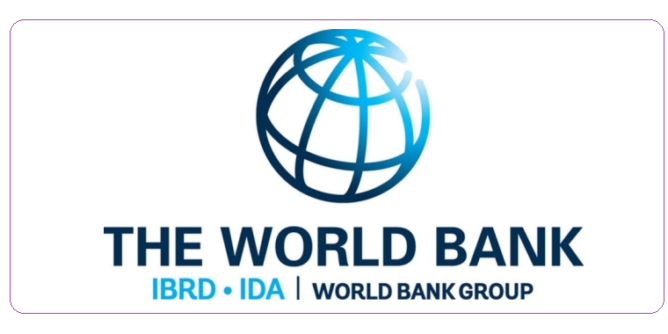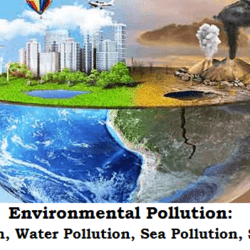
The World Bank was created at the 1944 Bretton Woods Conference, along with the International Monetary Fund (IMF) and provides loans to countries for capital programs. The International Bank for Reconstruction and Development (IBRD) and the International Development Association (IDA) are collectively known as the World Bank. The World Bank is a component of the World Bank Group, which is part of the United Nations system.
All decisions of World Bank will be guided to the promotion of foreign investment and international trade and to the facilitation of capital investment. India has been a founder member of the World Bank Group.
| Head Quarters: Washington, D.C. President (World Bank Group): David R. Malpass (USA) |
Aim of World Bank
- End extreme poverty by reducing share of global population that lives in extreme poverty ($1.9 per day) to 3% by 2030,
- Promote shared prosperity by increasing the income of the poorest 40% of people in every country
- Provide sustainable development
International Bank for Reconstruction and Development (IBRD)
IBRD provides loans and other assistance primarily to middle income and poor but credit worthy countries at interest rates slightly lower than that offered by other financial institutions but with long term maturity.
Membership
- To be a member of IBRD, a country has to join IMF first.
- Currently there are 188 member UN Countries
Functions
- Long-term capital assistance to its member-countries for their reconstruction and development.
- It works closely with the rest of the World Bank Group to help developing countries reduce poverty, promote economic growth, and build prosperity.
- Promotes policy and institutional reforms (such as safety net or anti-corruption reforms)
- Creates a favorable investment climate to catalyze the provision of private capital
Funding
- Like financial banks, it floats bonds in world financial markets where shareholders are member states.
- IBRD has a high credit rating (AAA) which allows it to borrow at low cost and offer loans to middle-income developing countries.
- IBRD earns income every year from the return on its equity and from the small margin it makes on lending.
- It receives contributions (donations) from developed member nations.
- It also provides an annual transfer of funds to IDA, the fund for the poorest countries.
Decision Making
- The IBRD is governed by the World Bank’s Board of Governors.
- It consists of one governor per member country (most often the country’s finance minister or finance secretary) and meets annually.
- The Board of Governors delegates most of its authority over daily matters such as lending and operations to the Board of Directors.
- The Board of Directors consists of 25 executive directors and is chaired by the President of the World Bank Group.
- The executive directors collectively represent all 188 member states of the World Bank.
International Development Association (IDA)
It is an international financial institution which offers concessional loans and grants to the world’s poorest developing countries. It was established in 1960 to complement the existing International Bank for Reconstruction and Development by lending to developing countries which suffer from the lowest gross national income, from troubled creditworthiness, or from the lowest per capita income.
Throughout its lifetime, 44 borrowing countries have graduated (above per capita income of $1145 including India, China, Indonesia, South Korea, Egypt)from the association, although a number of these countries have relapsed as borrowers after not sustaining their graduate status (such as Zimbabwe, Nigeria, Congo).
Aim
- To assist the poorest nations in growing more quickly, equitably, and sustainably to reduce poverty.
Membership
- Membership in the IDA is available only to countries who are members of the World Bank, particularly the IBRD.
- The IDA has 173 member countries which pay contributions every three years as replenishment of its capital.
Functions
- IDA provides loans at a zero or very low interest and for longer periods (35-40 years). Therefore, it is often referred to as the ‘soft loan window’ of the Bank.
- IDA alsoprovides grants to countries at risk of debt distress.
- Only the poorest of the poor member countries (with per capita income below $1145 in 2019) are eligible for assistance.
- IDA also supports a number of countries, including several small island economies, which are above the operational cutoff but lack the creditworthiness needed to borrow from IBRD.
- Some countries, such as India, are IDA-eligible based on per capita income levels, but are also creditworthy for some IBRD borrowing. They are referred to as “blend” countries”.
- IDA is a multi-issue institution, supporting a range of development activities, such as primary education, basic health services, clean water and sanitation, agriculture, business climate improvements, infrastructure, and institutional reforms.
- IDA complements the World Bank’s original lending arm, International Bank for Reconstruction and Development (IBRD).
Funding
- Member countries replenish its funds through contributions in addition to supplementary funds provided by the IBRD and the International Finance Corporation (IFC).
- Approximately half of the IDA’s resources come from the 60 donating member countries.
Decision Making
- The IDA is governed by the World Bank’s Board of Governors.
- It consists of one governor per member country (most often the country’s finance minister or finance secretary) and meets annually.
- The Board of Governors delegates most of its authority over daily
matters such as lending and operations to the Board of Directors.
- The Board of Directors consists of 25 executive directors and is chaired by the President of the World Bank Group.
- The executive directors collectively represent all 188 member states of the World Bank, although decisions regarding IDA matters concern only the IDA’s 173 member states.
World Bank and India
- Apart from being a lending institution to India it has also served as a worthy counsel whom India has approached for advice in difficulties.
- India has been the single largest borrower of it followed by Brazil, China and Mexico.
- Main sectors of assistance are roads & highways, energy, urban infrastructure (including water & sanitation), rural credit, disaster management and the financial services sector.
- The Bank has also been instrumental in the establishment of the India Development Forum (IDF), a consortium of donor nations to India. (earlier known as Aid India Consortium)
- The massive financial assistance pledged by the consortium members has been the largest aid commitment and is a landmark in the history of development aid from developed countries to developing countries.
- Though India is no longer eligible for concessional development funds, but World Bank has accepted for continued support given the high levels of poverty in the country. (Per capita income of India at the end of Mar, 2018 was $1977.)
Reports Released By World Bank
Ease of Doing Business (IBRD)
World Development Report (IBRD)
Global Economic Prospects

 Home
Home Syllabus
Syllabus Contact Us
Contact Us




